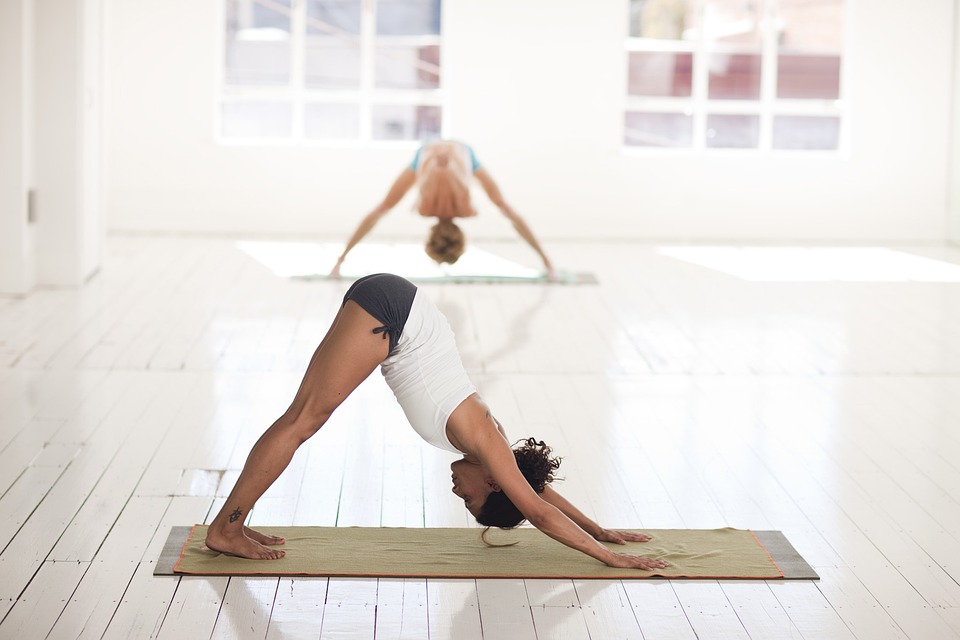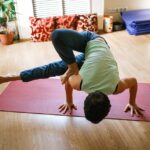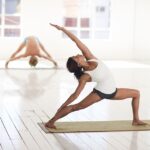There is a growing popularity for the practice of yoga throughout the world. Yoga is known to combine breathing, movement, and meditation all in one. Yoga was originally brought over to the United States from India over 100 years ago. People have praised yoga for a long time because of its physical and spiritual benefits.
Yoga has been shown to be beneficial in managing stress, improving mood, and enhancing sleep quality. It can also help ease anxiety and depression. Yoga has a plethora of benefits that have been shown through research. These benefits include increased flexibility, improved balance and coordination, reduced pain, and increased strength.
Although starting your first yoga class may feel daunting, it does not have to be if you are aware of what is coming. Most yoga classes last between 45 minutes and 90 minutes. Yoga class typically start with a period of centering focused on the breath, followed by asanas, and ending with meditation.
Yoga Basics
The most effective way to learn yoga is to attend a class; however, if you are feeling anxious about going to one, don’t hesitate to do some research first. Consider the following.
Types of Yoga
Different yoga classes can vary in style, so it’s a good idea to read the class descriptions at your local yoga studio to find one that matches what you’re looking for. Common types include:
- Hatha yoga classes tend to be good for beginners because they’re slower-moving.
- Vinyasa, Ashtanga, and power yoga classes can be more challenging, depending on the level of instruction.
- Iyengar has a strong focus on proper alignment, and often uses props to help students perfect their form.
- Hot yoga is yoga practiced in a hot environment—many studios reach 104 degrees F. Many people enjoy doing yoga in the heat, but people who are sensitive to heat or have certain medical conditions may find hot yoga uncomfortable.
- Kundalini yoga is the term for “a spiritual energy or life force located at the base of the spine.” In Kundalini yoga, practitioners use breathing exercises, physical postures, chanting and meditation to unlock this energy. It has been known to support healing addictions.
The Journal of Complementary and Alternative Medicine has published research which suggests that Kundalini yoga techniques can assist with disorders such as obsessive-compulsive disorder, phobias, addiction and substance abuse disorders, major depressive disorders, dyslexia, grief, insomnia, and other sleep disorders.
Breathing
Yoga’s strong focus on breathing can improve your health, according to research.
Rose says that yoga is mostly about the breath and not the poses. The most difficult part is just getting started, so if you can focus on taking deep breaths, you’re making progress.
A study published in Medical Science Monitor Basic Research in 2014 found that a single, 25-minute session of alternate nostril yoga breathing significantly decreased blood pressure and breathing rate in both hypertensive and healthy volunteers.
Poses
The names of yoga poses can be referenced in Sanskrit or English, or a combination of both, depending on the studio and instructor. The first few times you attend class, this can be confusing.
become familiar with some of the most common yoga poses, including both their English and Sanskrit names, as well as their basic form
Favorites like child’s pose (balasana) and downward facing dog (adho mukha svanasana) are incorporated into just about every yoga class. Some other common poses and sequences include warrior poses and sun salutations.
Supplies
Most studios encourage students to bring their own yoga mats to class, but if you don’t have a mat of your own, they usually have mats you can rent for a small fee. Ask your local studio what their guidelines are for attending classes. Otherwise, you’re unlikely to need much of anything.
Studios and gyms typically provide all the equipment you’ll need for your workout, including bolsters, blocks, and blankets.
If you’re thinking of doing yoga at home, you might want to buy a few key items, or look for things you can use around the house as substitutes. A yoga strap can be replaced with a belt or scarf, and yoga blocks can be replaced with throw pillows or a sturdy hard-cover book.
What To Wear
Wear clothes that are comfortable and allow you to move freely, like stretchy pants or shorts, and a close-fitting top that won’t fly up over your head when you do an inversion.
There is no need for special shoes when doing yoga as it is done barefoot. You can also wear socks with grips on the bottom to keep your feet from sliding around on your mat.
Class Settings
A yoga studio is typically where people go to learn about and practice yoga. There are other options for instruction besides online courses, each with its own advantages and disadvantages.
- Gyms: These days almost all large gyms offer yoga classes. If you already have a gym membership, you can often access classes at no additional cost. Many of these instructors are highly-qualified, although you might also get some new instructors looking to build their experience and skills.
- Yoga studios: Often home to highly-qualified instructors who focus primarily on yoga, most studios also offer a wide range of classes staggered throughout the day. However, yoga studios tend to be more expensive, and for some people, they can feel more intimidating.
- At home: with the availability of smartphones and streaming video services, you can access online classes from just about anywhere. Online classes or DVDs are an excellent and affordable option for those who don’t have access to in-person instruction, or those who want to ease into the practice before attending a class.
Although it is possible to start an at-home practice, this type of instruction does not provide personalized feedback. Therefore, it can be difficult for beginners to determine if they are correctly completing the poses. Joining yoga classes with an expert is ideal to get a hang of the ropes before you start practicing by yourself.
4 REASONS TO START A HOME PRACTICE
A quick tour through the benefits of establishing a regular (meaning you do it more days than you don’t) home yoga practice should motivate you to get started:
1. SELF-KNOWLEDGE.
Working on your own can assist you in understanding how to keep control and calm yourself. When you are driving your own car, you have a greater responsibility to pay attention and to choose where you are going and how you will respond to what happens as you travel along.
2. SELF-HELP.
The better you get at assessing how you feel, the more you can choose a practice that counterbalances whatever is going on mentally, physically, and emotionally.
3. SELF-INDULGENCE.
How many other things let you do whatever you want? “Practicing on your own is so indulgent,” Crandell says. You can spend anywhere from 2 to 90 minutes doing anything you want, at any pace, tone, and intensity you choose.
4. EXPONENTIAL GROWTH.
This means that the more regularly you practice yoga, the more cumulative the effects of each session will be. The consistency of the offer provides benefits that increase exponentially.
You can do this without spending any money and in your living room. If you want to have a successful home yoga practice, you need more than just inspiration. You also need a few guidelines to dispel the fear that you won’t be doing it right.
HOW TO DESIGN A HOME YOGA PRACTICE
If you want to improve your practice at home, follow these six tips. With them, you’ll have the confidence you need to know what you’re doing. The main point of the text is that doing a variety of yoga poses is beneficial to your practice, and that you can mix things up however you want in your home practice.
START WITH QUIET.
Before you start your yoga routine, it is important to be in a comfortable position. This can be done by sitting down or even lying down in corpse pose. This is something that she says in order to promote the idea of beginning with stillness in order to see how your body and mind feel. From there, you can make a decision on what to do next based off of those feelings.
PICK A DIRECTION.
This should depend on how you feel. If you don’t have much time and you’re feeling tired, do a short activity that will make you feel better. If you are feeling ready to go, choose a more vigorous practice. Poses that involve standing up are good for promoting feelings of grounding and stability. If you need energy, incorporate backbends. The stronger and more energetic you’ll be in the long run if you use your practice to take care of your immediate needs, according to Crandell.
SET AN INTENTION.
This simple suggestion ensures that you’ll use your time—no matter how short—in a way that is productive. Pearce-Hayden suggests creating a sense of spaciousness in a specific part of the body, working on a specific practice or pose, or noticing (and letting go of) any emotions that arise—without judgment as potential intentions for yoga practice.
CHOOSE POSES YOU LOVE.
There is a widely held belief that you should use your at-home practice to focus on the poses that give you the most difficulty. Throw that idea out the window, Crandell suggests. If you want a regular home practice, it needs to be something you want to do, not something you feel you have to do. Start by choosing four or five poses that you really enjoy, so you feel motivated to practice, rather than feeling like it’s a chore.
PAY ATTENTION IN CLASS.
Start taking note of the things you like during class so you can recreate them at home. For example, if you enjoy the sequence of moves that includes down dog, low lunge, down dog, and pigeon, make a mental note to do those three moves the next time you practice at home. I would be disappointed if my students weren’t applying what we do on a regular basis to their regular lives, Crandell says.
MOVE IN ALL DIRECTIONS.
Lee recommends that you select at least one pose for the different ways the body moves, such as leaning from side to side, bending forward or backward, twisting, and turning upside down (for example, downward dog or a standing forward bend). She says that if you include all the directions, you will have a well-rounded practice.
WHEN (AND WHERE) TO PRACTICE
You need to create both a physical and mental space in order to have a consistent home practice. Perhaps the biggest challenge is finding the time. To keep her home practice alive, Pearce-Hayden says she can’t let herself be swayed by the anxiety that nearly always pops up that she can’t afford to take any time away from getting things done. Taking even a little bit of time to practice grounds you and inspires you, so that when you return to your to-do list, you are more focused and productive. She has realized that when she gives herself just 10 or 15 minutes, the rest of her day feels more spacious.
Dedicating an area of your home to your yoga practice can help make room in your mind for it to become a habit. The physical space you create doesn’t need to be big, attractive, or serene. “I’ve been doing yoga for years on a tiny piece of floor space between the fireplace and coffee table that’s just the right size for a yoga mat,” Lee says. Lee claims that you will become fully immersed in your practice after only two breaths when you are in your special spot. “Just looking at it will be a trigger.”
HOW TO KEEP GOING, NO MATTER WHAT
What about when you’re feeling sick or when life gets too busy to even do a 5 minute yoga pose? Get creative. ” A yoga practice is designed to help you take notice of your actions and reactions. Pearce-Hayden says that it doesn’t have to take a certain form. How do you get better at yoga? Practice. You can practice mindfulness by paying attention to your reactions at work or while standing in line at the grocery store. It means being present in the moment and not letting your thoughts wander. It could mean being completely focused on your child during the next diaper change, or washing the dishes without letting your mind wander.
This well-known Iyengar teacher once said that if you can breathe, you can do yoga. Performing gentle pranayama exercises or meditating while you are in bed or on hold for a conference call can help to pass the time. What really matters is your dedication. Lee explains that anything that requires practice also necessitates commitment, patience, and self-forgiveness.



